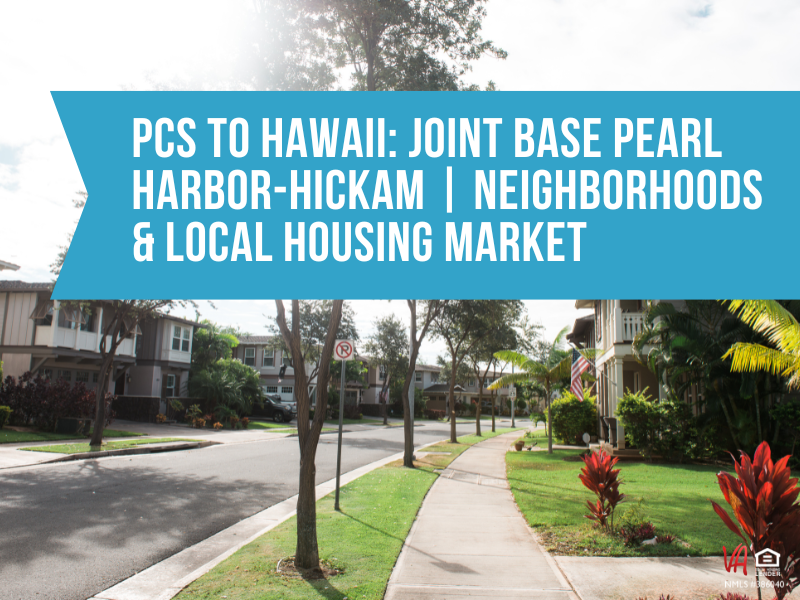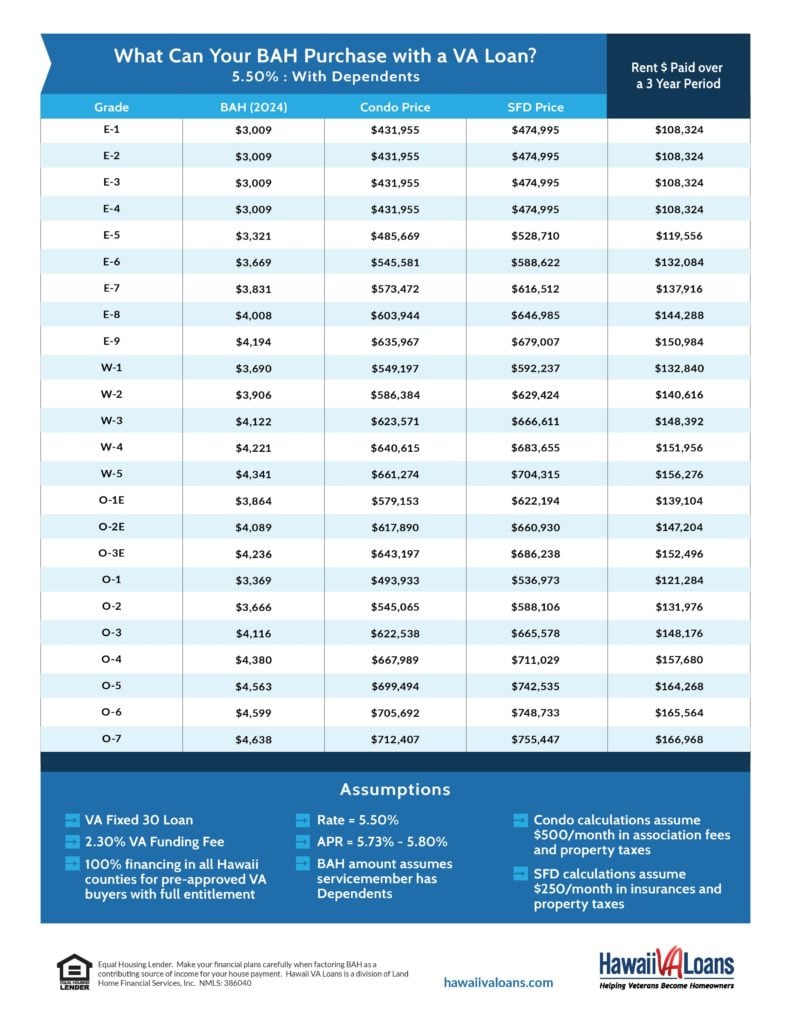Congratulations on your PCS to Hawaii! Joint Base Pearl Harbor-Hickam is located eight miles west of Honolulu. Steeped in history and culture, its surrounding neighborhoods are sure to peak your interests and you’ll have many areas to choose to live.

Hawaii VA Loans is the longest-running VA loan specialized lender in Hawaii. Since 2007, we’ve helped hundreds of Servicemembers and Veterans purchase their island home. So let’s take a look at the neighborhoods and local housing market surrounding Joint Base Pearl Harbor-Hickam.
Joint Base Pearl Harbor-Hickam Neighborhoods: Aiea, Ewa Beach, Honolulu, Kapolei/Makakilo
Aiea
The town of Aiea lies 16 miles north of Pearl Harbor-Hickam and is a 30 minute commute to JBPHH. Kamehameha Highway (Hawaii Route 90) divides most of Aiea from the shore of Pearl Harbor and the parallel major thoroughfare, Interstate H-1, further cuts the town’s commercial district into two distinct areas.The residential area known as Aiea Heights extends up the ridgeline above the town. The communities of Newtown Estates and Royal Summit are located at the western edge of Aiea near its border with Pearl City at Kaahumanu Street.
Living in Aiea will give you a short, five mile commute to Honolulu International Airport, and easy access to Hawaii’s largest enclosed shopping center, Pearlridge Mall. The mall is separated into two sections, known as Uptown and Downtown, and includes a monorail. There is a hospital located on mall property (Pali Momi Medical Center), and Hawaii’s largest watercress farm, Sumida Farm. Aloha Stadium, is located nearby hosting weekly swap meets, and many other community sporting events and major concerts like Hawaii’s own Bruno Mars.
Aiea Weather
The hot season in ‘Aiea lasts for 3.6 months, from June 25 to October 13, with an average daily high temperature above 85°F. The hottest month of the year is August, with an average high of 87°F and low of 74°F.
The cool season lasts for 3.7 months, from December 11 to April 2, with an average daily high temperature below 81°F. The coldest month of the year in ‘Aiea is January, with an average low of 67°F and high of 79°F.
Rain falls throughout the year in ‘Aiea. The month with the most rain in ‘Aiea is January, with an average rainfall of 2.5 inches.
Ewa Beach
‘Ewa is located on the Leeward coast of Oahu, just 15 miles (approx. 25 minute commute) from Joint Base Pearl Harbor-Hickam. The main thoroughfare is Fort Weaver Road (State Rte. 76) which runs north (away from the coast) past Ewa to Waipahu, connecting there to Farrington Highway (State Rte. 90) and the H-1 freeway. As of the 2010 Census, Ewa had a total population of 14,955.
Approximately 16 miles (25 minute drive) from Honolulu International Airport, the postal code for Ewa Beach extends inland to the developments of Ocean Pointe, ʻEwa Gentry, Iroquois Point, and ʻEwa Villages offering town homes, single family homes, golf course homes, and a bustling community.
OCEAN POINTE, EWA GENTRY, EWA VILLAGES
In the late 19th century to early 20th century, ʻEwa was one of the large population centers on the Island of Oʻahu, with industry focused around sugar cane production. The ʻEwa Mill was a major employer that set up residential villages. Sugar cane is no longer grown on the ʻEwa Plain and Ocean Pointe, Ewa Gentry, and Ewa Villages are now part of Oʻahu’s new suburban growth center, an area of substantial sprawl spreading unbroken to the south to ʻEwa Beach, north to Honolulu, and west to Kapolei.
IROQUOIS POINT
“Iroquois Point” refers to the geographic land area that is occupied by the Waterfront at Pu’uloa (known as “Iroquois Point Island Club” prior to 2008), a firing range, a Navy Exchange shoppette and gas station, and Iroquois Point Elementary School. Once primarily used as a military housing community, it is now privately operated.
Ewa Beach Weather
In ‘Ewa Beach, the summers are hot, muggy, and dry; the winters are comfortable; and it is windy and mostly clear year round. Over the course of the year, the temperature typically varies from 66°F to 88°F and is rarely below 61°F or above 90°F.
Rain falls throughout the year in ‘Ewa Beach. The month with the most rain in ‘Ewa Beach is January, with an average rainfall of 2.5 inches.
Honolulu
Honolulu is the state capital and the most populated city in Hawaii. The city is a major hub for international business, military defense, as well as hosting a diverse variety of east-west and Pacific culture, cuisine, and traditions. It is the major financial center of the islands. Living in the center of Honolulu would give you about a 30 minute commute to JBPHH and a short 13 minutes to Honolulu International Airport.
NEIGHBORHOODS, BOROUGHS, AND DISTRICTS OF HONOLULU
- Downtown Honolulu is the financial, commercial, and governmental center of Hawaii. On the waterfront is Aloha Tower, which for many years was the tallest building in Hawaii. Currently the tallest building is the 438-foot (134m) tall First Hawaiian Center, located on King and Bishop Streets. The downtown campus of Hawaii Pacific University is also located there.
- The Arts District Honolulu in downtown/Chinatown is on the eastern edge of Chinatown. It is a 12-block area bounded by Bethel & Smith Streets and Nimitz Highway and Beretania Street – home to numerous arts and cultural institutions. It is located within the Chinatown Historic District, which includes the former Hotel Street Vice District.
- The Capitol District is the eastern part of Downtown Honolulu. It is the current and historic center of Hawaii’s state government, incorporating the Hawaii State Capitol, ʻIolani Palace, Honolulu Hale (City Hall), State Library, and the statue of King Kamehameha I, along with numerous government buildings.
- Kakaʻako is a light-industrial district betweencDowntown and Waikīkī that has seen a large-scale redevelopment effort in the past decade. It is home to two major shopping areas, Ward Warehouse and Ward Centre. The John A.Burns School of Medicine, part of the University of Hawaiʻi at Manoa is also located there.
- Ala Moana is a district between Kakaʻakocand Waikīkī and the home of Ala Moana Center, the “World’s largest open air shopping center” and the largest shopping mall in Hawaii. Ala Moana Center boasts over 300 tenantscand is a very popular location among tourists.cAlso in Ala Moana is the Honolulu Design Center and Ala Moana Beach Park, the second largest park in Honolulu.
- Waikīkī is the tourist district of Honolulu, located between the Ala Wai Canal and the Pacific Ocean next to Diamond Head. Numerous hotels, shops, and night life opportunities are located along Kalakaua and Kuhio Avenues. It is a popular location for visitors and locals alike and attracts millions of visitors every year. A majority of the hotels on Oahu are located in Waikīkī.
- Manoa and Makiki are residential neighborhoods located in adjacent valleys just inland of downtown and Waikīkī. Manoa Valley is home to the main campus of the University of Hawaiʻi.
- Nuʻuanu and Pauoa are upper-middle-class residential districts located inland of downtown Honolulu. The National Memorial Cemetery of the Pacific is located in Punchbowl Crater fronting Pauoa Valley.
- Palolo and Kaimuki are neighborhoods east of Manoa and Makiki, inland from Diamond Head. Palolo Valley parallels Manoa and is a residential neighborhood. Kaimuki is primarily a residential neighborhood with a commercial strip centered on Waialae Avenue running behind Diamond Head. Chaminade University is located in Kaimuki.
- Waialae and Kahala are upper-class districtsof Honolulu located directly east of Diamond Head, where there are many high-priced homes. Also found in these neighborhoods are the Waialae Country Club and the five-star Kahala Hotel & Resort.
- East Honolulu includes the residential communities of ‘Āina Haina, Niu Valley, and Hawaiʻi Kai. These are considered upper-middle-class neighborhoods. The upscale gated communities of Waiʻalaeʻiki and Hawaiʻi Loa Ridge are also located here.
- Kalihi and Palama are working-class neighborhoods with a number of government housing developments. Lower Kalihi, toward the ocean, is a light-industrial district.
- Salt Lake and Aliamanu are (mostly)residential areas built along the western end of the Honolulu District, not far from the Honolulu International Airport.
- Moanalua is two neighborhoods and a valley at the western end of Honolulu, and home to Tripler Army Medical Center.
The population of Honolulu was 390,738 according to the 2010 U.S.Census.
Honolulu Weather
The hot season lasts for 3.6 months, from June 27 to October 14, with an average daily high temperature above 85°F. The hottest month of the year in Honolulu is August, with an average high of 87°F and low of 76°F.
The cool season lasts for 3.6 months, from December 13 to April 1, with an average daily high temperature below 81°F. The coldest month of the year in Honolulu is January, with an average low of 68°F and high of 79°F.
The month with the most rain in Honolulu is January, with an average rainfall of 2.4 inches.
Kapolei/Makakilo
Located west of Ewa Beach, the city of Kapolei is known as the “second city”of Oahu in relation to Honolulu. Planned as the second “urban center” on the island of Oahu, initial residential construction in the Kapolei area began in the late 1980s, with commercial developments springing up shortly thereafter. Two decades later, the Kapolei area has seen massive growth, and has become the center of business in the West Oahu region of the island. In fact, our first of two Hawaii VA Loans offices is located in the business district of Kapolei (the other is located in Kailua).
Kapolei is approximately 17 miles from JBPHH and is a 25 minute commute. Other communities in the Kapolei area are Makakilo and Naval Air Station Barbers Point (now known as Kalaeloa). Further on is Barbers Point Harbor, and the resort and marina community of Ko Olina, which includes the Disney Aulani Resort and Ko Olina Golf Club.
Makakilo is located on the southern end of the slopes of the Waianae mountain range above the city of Kapolei. The Interstate H-1 freeway divides more recently developed Kapolei from Makakilo, and traveling eastward on H-1 connects to Waipahu.
As of the 2010 census, Kapolei had a population of 15,186 people. Makakilo had a population of 18,248.
Kapolei/Makakilo Weather
The hot season lasts for 3.7 months, from June 19 to October 10, with an average daily high temperature above 86°F. The hottest month of the year in Kapolei is August, with an average high of 88°F and low of 73°F.
The cool season lasts for 3.6 months, from December 11 to March 30, with an average daily high temperature below 82°F. The coldest month of the year in Kapolei is January, with an average low of 66°F and high of 80°F.
The month with the most rain in Kapolei is January, with an average rainfall of 2.5 inches.
Oahu Local Housing Market: Aiea, Ewa Plain, West Honolulu, Makakilo
The following local market data for condos and single family homes near Joint Base Pearl Harbor-Hickam is updated from the Oahu Local Market Update as of November 2023 by Honolulu Board of Realtors. Monthly rental prices are provided by Zillow.com.
After you take a look at the local market data, compare monthly rental prices to what your monthly Basic Allowance for Housing (BAH) can purchase with a VA home loan. Why pay someone else’s mortgage by renting when you can use your BAH to invest in yours?
| Neighborhood | Median Condo Price | Median Single Family Home Price | Average Monthly Rental Price (3-bedroom) |
| Pearl City – Aiea | $465,000 | $975,000 | $3,000 |
| Ewa Plain | $678,500 | $888,000 | $3,580 |
| Kalihi Valley | $405,000 | $900,000 | $3,600 |
| Makakilo | $550,000 | $1,030,000 | $3,800 |

What do these prices mean for your housing budget if you PCS to Joint Base Pearl Harbor-Hickam, Hawaii? Let’s take a look at Honolulu County’s BAH rates to find out what estimated condo or single family home purchase price you could make solely using your BAH as the monthly mortgage payment.
Want to purchase? We can help with a VA loan! PRE-APPROVED VA buyers with full entitlement are able to purchase a home with no down payment. VA buyers with remaining entitlement (those who have one or more existing VA mortgages) will use Hawaii’s conforming loan limit set by the FHFA to calculate down payment. Contact us to get started by calling 808-792-4251 or fill out our secure online loan application.

